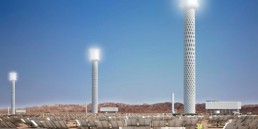We learned of yet another “twist” on solar power generation via this Forbes article about the ARPA-E conference in Washington D.C.
The Solar Vortex borrows its inspiration from dust devils, those miniature twisters of excited dirt that sometimes arise in the dusty and dry stretches of the U.S. Southwest. What gets a dust devil going is the difference in temperature between the scorching-hot ground and the somewhat cooler air above. The hot air rises, twists and gives rise to a momentary dust tornado.
Georgia Tech is the leader of a consortium that aims to capture this dust-devil energy inside a stubby cylinder. The concept is simple: The cylinder sits upon a dark surface that absorbs lots of heat. The “walls,” so to speak, are angled vanes that take the hot air rising off that hot surface and twist it into a vortex. At the top, a set of fan blades sit in the path of the rising air. The fan blades turn, activating a generator that creates electricity.
The video below is a miniature model of the Solar Vortex on the exhibition floor. The cylinder sits on a plate that is, like hot pavement, almost too hot to touch, about 47 degrees Celsius (116 degrees Fahrenheit). The movement you see in the blade is solely from the force of moving air.
More from the Forbes article:
Georgia Tech has already purchased gotten rights to use a site in Mesa, Arizona — plenty of heat there — and is working toward building a 50-kilowatt commercial-scale model. Final negotiations with ARPA-E are underway for an intermediate step: a 10-kilowatt version by 2015. Arne Pearlstein, a professor of mechanical engineering who is a collaborator, told me that the commercial-scale version might be 10 meters wide but only two or three meters tall, and that the units would sit about 55 meters apart. These squat machines could bring renewable energy to regions that are bombarded by heat but don’t have much wind. (Though gusts of wind would only serve to make the turbine spin faster, Pearlstein said.)
Pearlstein estimated that the Solar Vortex could spin out electricity 20 percent cheaper than wind turbines and 65 percent cheaper than solar photovoltaic panels. One form of saving comes from its potentially straightforward maintenance. “You’re talking about somebody getting up on a stepladder instead of going hundreds of meters up into a wind turbine to deal with a gearbox,” Pearlstein said.
It seems that this idea could have a lot of potential for conceptually inspired applications that would make a larger Solar Vortex installation a real destination art piece.
More information on the Georgia Tech research can be found here (more diagrams and videos). In searching for more information on the idea, we came across a number of similar concepts and pending patents. More examples of supporters of the technology can be found here and here.


